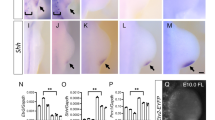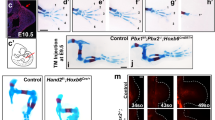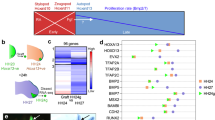Abstract
The development of the vertebrate limb serves as an amenable system for studying signaling pathways that lead to tissue patterning and proliferation1. Limbs originate as a consequence of a differential growth of cells from the lateral plate mesoderm at specific axial levels2. At the tip of the limb primordia the progress zone, a proliferating group of mesenchymal cells, induces the overlying ectoderm to differentiate into a specialized structure termed the apical ectodermal ridge. Subsequent limb outgrowth requires reciprocal signalling between the ridge and the progress zone3,4,5,6. The Rel/NF-κB family of transcription factors is induced in response to several signals that lead to cell growth, differentiation, inflammatory responses, apoptosis and neoplastic transformation7. In unstimulated cells, NF-κB is associated in the cytoplasm with an inhibitory protein, I-κB. In response to an external signal, I-κB is phosphorylated, ubiquitinated and degraded, releasing NF-κB to enter the nucleus and activate transcription7. Here we show that Rel/NF-κB genes are expressed in the progress zone of the developing chick limb bud. When theactivity of Rel/NF-κB proteins is blocked by infection with viral vectors that produce transdominant-negative I-κBα proteins, limb outgrowth is arrested. Our results indicate that Rel/NF-κB transcription factors play a role in vertebrate limb development.
This is a preview of subscription content, access via your institution
Access options
Subscribe to this journal
Receive 51 print issues and online access
$199.00 per year
only $3.90 per issue
Buy this article
- Purchase on Springer Link
- Instant access to full article PDF
Prices may be subject to local taxes which are calculated during checkout




Similar content being viewed by others
Change history
16 June 2014
Owing to an HTML symbol conversion error the superscript number 2 for author A.T.T. should have been 3; the error was corrected on 16 June 2014.
References
Tickle, C. & Eichele, G. Vertebrate limb development. Annu. Rev. Cell Biol. 10, 121–152 (1994).
Searls, R. L. & Janners, M. Y. The initiation of limb bud outgrowth in the embryonic chick. Dev. Biol. 24, 198–213 (1971).
Saunders, J. W. J. The proximo-distal sequence of the origin of the parts of the chick wing and the role of the ectoderm. J. Exp. Zool. 108, 363–404 (1948).
Kieny, M. Rôle inducteur du mésoderme dans la différenciation précoce du bourgeon de membre chez l'embryon de Poulet. J. Bembryol. Exp. Morphol. 8, 457–467 (1960).
Summerbell, D. Aquantitative analysis of the effect of excision of the AER from the chick limb bud. J. Embryol. Exp. Morphol. 32, 651–660 (1974).
Rowe, D. A. & Fallon, J. F. The proximodistal determination of skeletal parts in the developing chick leg. J. Embryol. Exp. Morphol. 68, 1–7 (1982).
Verma, I. M., Stevenson, J. K., Schwarz, E. M., Van Antwerp, D. & Miyamoto, S. Rel/NF-kappa B/I kappa B family: intimate tales of association and dissociation. Genes Dev. 9, 2723–2735 (1995).
Hamburger, V. & Hamilton, H. Aseries of normal stages in the development of the chick embryo. J. Morphol. 88, 49–92 (1951).
Davidson, D. R., Crawley, A., Hill, R. E. & Tickle, C. Position-depenent expression of two related homeobox genes in developing vertebrate limbs. Nature 352, 429–431 (1991).
Chen, Z. F. & Behringer, R. R. Twist is required in head mesenchyme for cranial neural tube morphogenesis. Genes Dev. 9, 686–699 (1995).
Niswander, L., Tickle, C., Vogel, A., Booth, I. & Martin, G. R. FGF-4 replaces the apical ectodermal ridge and directs outgrowth and patterning of the limb. Cell 75, 579–587 (1993).
Fallon, J. F.et al. FGF-2: apical ectodermal ridge growth signal for chick limb development. Science 264, 104–107 (1994).
Laufer, E., Nelson, C. E., Johnson, R. L., Morgan, B. A. & Tabin, C. Sonic hedgehog and Fgf-4 act through a signaling cascade and feedback loop to integrate growth and patterning of the developing limb bud. Cell 79, 993–1003 (1994).
Niswander, L., Jeffrey, S., Martin, G. R. & Tickle, C. Apositive feedback loop coordinates growth and patterning in the vertebrate limb. Nature 371, 609–612 (1994).
Crossley, P. H., Minowada, G., MacArthur, C. A. & Martin, G. R. Roles for FGF-8 in the induction, initiation and maintenance of chick limb development. Cell 84, 127–136 (1996).
Vogel, A., Rodriguez, C. & Izpisúa Belmonte, J. C. Involvement of FGF-8 in initiation, outgrowth and patterning of the vertebrate limb. Development 122, 1737–1750 (1996).
Van Antwerp, D. J., Martin, S. J., Kafri, T., Green, D. R. & Verma, I. M. Suppression of TNF-alpha-induced apoptosis by NF-kappaB. Science 274, 787–789 (1996).
Inoue, J.et al. c-rel activates but v-rel suppresses transcription from kappa B sites. Proc. Natl Acad. Sci. USA 88, 3715–3719 (1991).
Riddle, R. D., Johnson, R. L., Laufer, E. & Tabin, C. Sonic hedgehog mediates the polarizing activity of the ZPA. Cell 75, 1401–1416 (1993).
Shen, R., Chen, Y., Huang, L., Vitale, E. & Solursh, M. Characterization of the human MSX-1 promoter and an enhancer responsible for retinoic acid induction. Cell Mol. Biol. Res. 40, 297–312 (1994).
Jiang, J., Kosman, D., Ip, Y. T. & Levine, M. The dorsal morphogen gradient regulates the mesoderm determinant twist in early Drosophila embryos. Genes Dev. 5, 1881–1891 (1991).
Howard, T. D.et al. Mutations in TWIST, a basic helix-loop-helix transcription factor, in Saethre-Chotzen syndrome. Nature Genet. 15, 36–41 (1997).
el Ghouzzi, V.et al. Mutations of the TWIST gene in the Aethre-Chotzen syndrome. Nature Genet. 15, 42–46 (1997).
Shishido, E., Higashijima, S., Emori, Y. & Saigo, K. Two FGF-receptor homologues of Drosophila : one is expressed in mesodermal primordium in early embryos. Development 117, 751–761 (1993).
MacArthur, C.et al. FGF-8 isoforms activate receptor splice forms that are expressed in mesenchymal regions of mouse development. Development 121 (suppl.), 3603–3613 (1995).
Deng, C.et al. Fibroblast growth factor receptor-1 (FGFR-1) is essential for normal neural tube and limb development. Dev. Biol. 185, 42–54 (1997).
Robert, B., Lyons, G., Simandl, B.-K., Kuroiwa, A. & Buckingham, M. The apical ectodermal ridge regulates Hox-7 and Hox-8 gene expression in developing limb buds. Genes Dev. 5, 2363–2374 (1991).
Ogura, T.et al. Evidence that Shh cooperates with a retinoic acid inducible co-factor to establish ZPA-like activity. Development 122, 537–542 (1996).
Izpisúa Belmonte, J. C., De Robertis, E. M., Storey, K. G. & Stern, C. The homeobox gene goosecoid and the origin of organizer cells in the early chick blastoderm. Cell 74, 645–659 (1993).
Miyake, S.et al. Efficient generation of recombinant adenoviruses using adenovirus DNA-terminal protein complex and a cosmid bearing the full-length virus genome. Proc. Natl Acad. Sci. USA 93, 1320–1324 (1996).
Acknowledgements
We thank T. Gilmore, R. Hrdlickova and H. R. Bose for reagents; M. Pando, D. Van Antwerp, I Saito, C. Rays, J. De La Peña, C. De La Peña and C. Rodriguez-Esteban for suggestions and help with virus infection and in situ hybridizations; and B. Coyne and L. Hooks for help in assembling the manuscript. Y.K. is on leave of absence from the Institute of Medical Science, The University of Tokyo. This work was supported by a fellowship from the Gulbenkian Foundation (PGDBM) and Program PRAXIS XXI (A.T.T.), grants from the NIH, NIH and the Wayne and Gladys Valley Foundation (I.M.V.) and grants from the NSF, NIH and the G. Harold and Leyla Y. Mathers Charitable Foundation (J.C.I.B.). J.C.I.B. is a Pew Scholar. I.M.V. is an American Cancer Society Professor of Molecular Biology.
Author information
Authors and Affiliations
Corresponding author
Supplementary Information
Supplementary Information
Supplementary Information
Supplementary Information
Rights and permissions
About this article
Cite this article
Kanegae, Y., Tavares, A., Belmonte, J. et al. Role of Rel/NF-κB transcription factors during the outgrowth of the vertebrate limb. Nature 392, 611–614 (1998). https://doi.org/10.1038/33429
Received:
Accepted:
Issue Date:
DOI: https://doi.org/10.1038/33429
This article is cited by
-
Osteoarthritis: pathogenic signaling pathways and therapeutic targets
Signal Transduction and Targeted Therapy (2023)
-
NF-κB activity during pancreas development regulates adult β-cell mass by modulating neonatal β-cell proliferation and apoptosis
Cell Death Discovery (2021)
-
Ikk2 regulates cytokinesis during vertebrate development
Scientific Reports (2017)
-
Differential expression of osteopontin, and osteoprotegerin mRNA in epicardial adipose tissue between patients with severe coronary artery disease and aortic valvular stenosis: association with HDL subclasses
Lipids in Health and Disease (2017)
-
Profiling microRNA expression during fracture healing
BMC Musculoskeletal Disorders (2016)
Comments
By submitting a comment you agree to abide by our Terms and Community Guidelines. If you find something abusive or that does not comply with our terms or guidelines please flag it as inappropriate.



